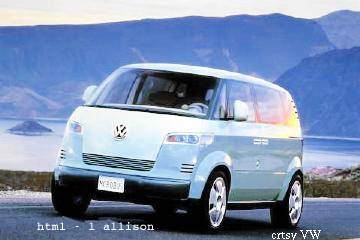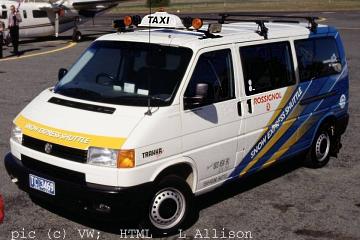VW military 4x4 Transporter Transporter |
Rear engined
The Volkswagen Transporter is a car of legend. Born of Volkswagen Beetle mechanical parts, the boxy deliver van became the VW Combi, the flower people's palace on wheels, travelling through Europe, California, and more adventurously India and Morocco, and some of them still do. Ageing hippies turn misty eyed at the thought.

4WD Syncro
From 1955 to 1976 Volkswagen Transporters were also assembled from kits at Clayton in Victoria, Australia. (The factory was subsequently acquired by Nissan.) The panel fit was not as good as on imported Transporters but the locals went just as well. Volkswagen reports that 77,800 Transporters were registered in Australia.
Volkswagen's air-cooled flat-4 engines have a reputation for rattling on forever, although oil leaks can be a chronic problem and seized valves are not unknown. The rear engined layout put the weight over the rear wheels and gave good traction, but it made the engine susceptible to damage from dust drawn into the air intake on dirt roads. Raised air intakes improved matters.
Volkswagen's final 1982 incarnation of the rear engined Transporter had a water-cooled engine which cured occasional problems with sticking-valves, allowed closer tolerances for reduced emissions, and lowered noise levels. It also introduced the Syncro four wheel drive Transporter which had quite surprising offroad abilities. The 4WD modifications were carried out by Steyr Daimler Puch, part of the deal being that Steyr could use Volkswagen's diesel in their own Pinzgauer. Many VW Syncros were made into four wheel drive campers so that you could go offroading in luxury.
- From VW:
- 1950: first transporter, rear engined, air-cooled, 4x2
- 1955: assembly begins in Clayton Victoria (end 1976)
- 1968: Mk2 Transporter, Y-frame chassis
- 1982: Mk3 Transporter, water cooled, 4x2 or Syncro 4WD
- 1992: front wheel drive (below)
- 1955: assembly begins in Clayton Victoria (end 1976)
Tom Niksch writes:
Type II is used by Volkswagen as a general name
for all the Transporters,
To make confusion complete: In the mid to late 1970's there were first 4WD Transporter prototypes built, based on the Type II, T2 with the 70hp air-cooled 2.0 litre Boxer. Steyr-Puch was not involved until the Type II T3 4WD (later named "Syncro") was developed and manufactured in the mid 1980s.
- A few additions on the (T3) syncro production figures: (source SDP Graz/Austria)
- T3 Syncro total: 43,468, including:
- LHD: 41,360
- RHD: 2,108
- engines:
- 2.1 l i (95 hp) 14,233
- 2.1 l i (112 hp) 6,259
- 1.9 l (78 hp) 6,641
- 1.6TD (70 hp) 16,335
- Transporter
- Pritschenwagen Pick-Up Single Cab (245) 1,787
- Doppelkabine Pick-Up Double Cab (247) 6,849
- Kastenwagen Van, panels (251) 5,848
- Kombi Bus (253) 14,650
- Caravelle Bus (255) 14,334
- 16" package: 2,138
Front engined
Volkswagen released its new Transporter vans in 1992, moving the engine to the front and also driving the front wheels. It made a lot of sense in terms of improved crash worthiness and increased internal space - allowing a full-length, low floor.

4WD Syncro
The Volkswagen Transporter was available as a van (short and long wheel base) and as a crew-cab pickup (above). A people-mover version, the Volkswagen Caravelle, became available in Australia in late 1997.
Volkswagen Transporters can be ordered with the optional Syncro "constant four wheel drive system" by a viscous coupling. Volkswagen held to "4WD" terminology rather than the "AWD" alternative. The engine and transmission are transversely mounted in the nose to provide front wheel drive. In the Syncro Transporter, drive is taken off the front differential's crown wheel by a pinion to a propeller shaft. This is in three sections, joined by constant velocity joints, and takes the drive to a rear differential. The viscous coupling is incorporated in the input to the differential. There is no dog-clutch to rigidly lock the viscous coupling.
Rear suspension remains independent by semi-trailing arms on the Syncro, as for the front wheel drive models.
The 1990s' Transporter Syncro is not as capable an offroader as the old rear-engined Syncro which had quite surprising abilities, particularly in the tougher 16"-wheel version. The modern Syncro is more of a slippery-roader than an offroader.
Volkswagen Transporter Series
- Transporter Van, 3 seats, 3 doors
- loa: 4707mm, width: 1620mm, height: 1415mm
- wheelbase: 2920mm, track: 1589mm/1554mm, grnd clearance: 180mm
- turning radius: 5.85m
- weight: 1525kg-1695kg (unladen), GVM: 2800kg, towing: 700kg (unbraked)
- Engines:
- 2L petrol:
- Digifant 1968cc, petrol, 4-cyl
- 62kW at 4300rpm, 159Nm at 2200rpm
- 2.5L petrol:
- Simos 2461cc, petrol, 5-cyl
- 85kW at 4500rpm, 200Nm at 2200rpm
- 2.4L Diesel:
- 2370cc, diesel, 5-cyl
- 57kW at 3700rpm
- 164Nm at 1800rpm-2200rpm
- 2L petrol:
- transmission: 5m/4a, Syncro: front wheel drive + drive to rear wheels via viscous coupling
- suspension: indep'+torsion-bars/ semi-trailing-arms+coils, brakes: disc/disc
- wheels: 6Jx15, fuel-tank: 80L
- Price: from $28K (4x2 van) $au, 1997, 1998
Transporter SWB 2.5 petrol or 2.4 diesel 5-spd Synco 4WD $38,490 rrp
Transporter LWB 2.5 petrol or 2.4 diesel 5-spd Synco 4WD $40,490 rrp
Transporter cCab 2.5 petrol or 2.4 diesel 5-spd Synco 4WD $39,990 rrp
Transporter cab chassis 2.5 petrol or 2.4 diesel 5-spd Synco 4WD $35,990 rrp (1998)
Long Wheel Base Van and Crew Cab:
- wheel base: 3320mm, van loa: 5107mm, crew-cab loa: 5136mm
- turning radius: 6.45m, weight: 1645kg - 1745kg,

Concept Microbus 2001

Syncro July 2002
- 2010: By 2010 the Multivan people-mover (7 to 9 seats) models had
- a 2-litre diesel with either a
single turbo (103kW, 340Nm), ortwin-turbos (132kW, 400Nm), - 8.1 l/100km claimed,
- 7-speed twin-clutch DSG gearbox, and
- front-wheel drive or 4motion 4-wheel drive,
- from $50K (Comfortline), to $74K (Highline) ($au, 7/2010).
- 8.1 l/100km claimed,
|
www #ad: |